Top 15 Types of Hawks in the United States
Last Updated on
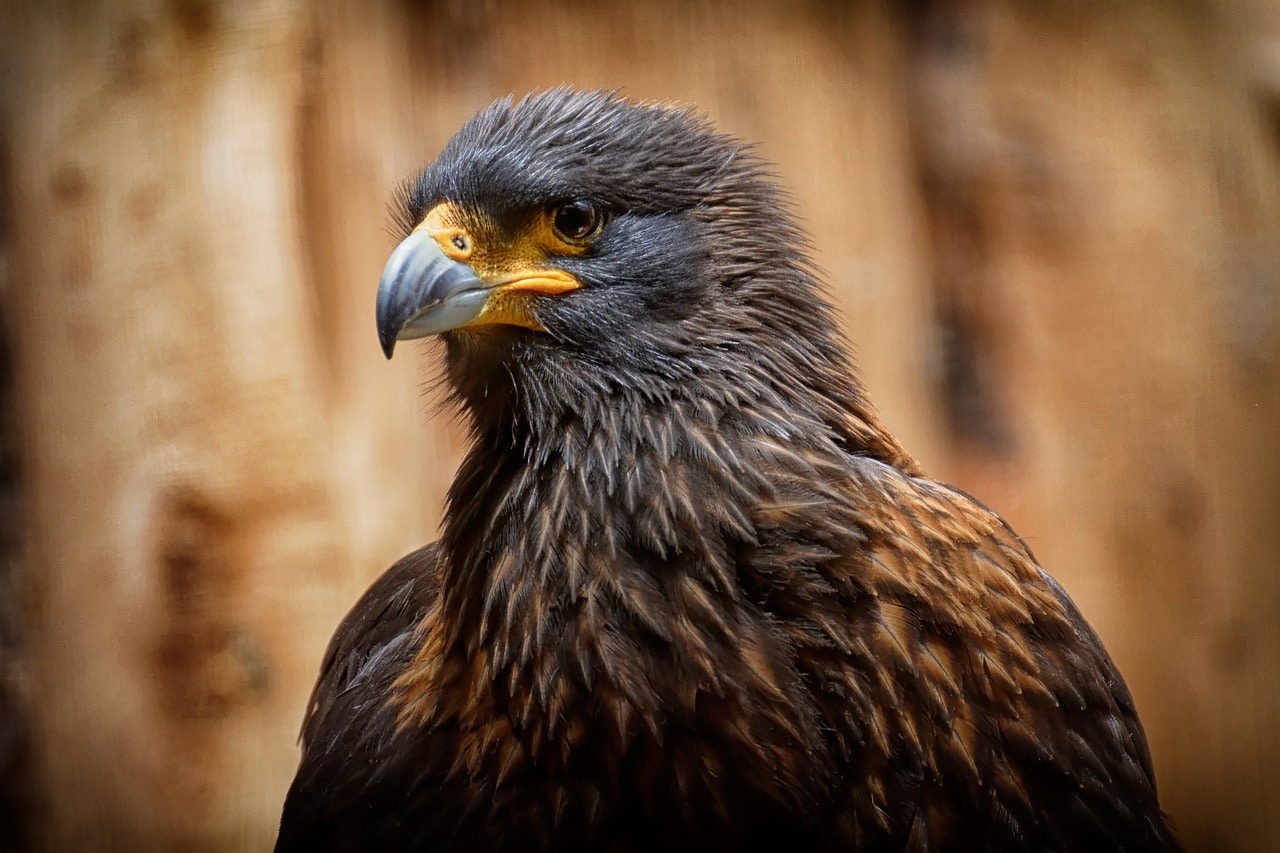
Hawks are some of the top predators in the avian world. From a taxonomy point-of-view, they belong to the family Accipitridae. All have a distinctive body form, with a sharp, hooked bill and equally pointed talons or claws.
Both features give them superb hunting skills. Other distinguishing characteristics include keen vision and awareness of their surroundings. That makes them successful hunters. So deadly are these predators that prey species instinctively recognize the silhouette of a hawk flying overhead and flee, the so-called hawk-goose effect.
There are around 200 hawk species worldwide, with around 25 living in the wild in the United States in 2021.
The family Accipitridae includes both small and large hawk species. They vary in their hunting style, body shape, and size. Some specialize in a particular type of prey, which explains why you may see some referred to as sparrow hawks or chicken hawks. There are three main subfamilies that we’ll consider in detail as we discuss our top 15 hawk species you can find in the United States.

Top 15 Types Of Hawk in the US
Accipiters
1. Northern Goshawk (Accipiter gentilis)

The Northern Goshawk is a robust bird, with sizes reaching between 20–26” and a wingspan of 40.5–46.1”. Its distinguishing feature is a white stripe above its eyes and a black swath starting at the distal end of each one. It is primarily dark gray on its back, with a white mottled chest. Like other species in this group, it has a relatively long, thin tail with dark stripes.
The Northern Goshawk lives primarily in mature forests, where it is a significant predator of small mammals and birds. It hunts with a swift sneak attack. The hawk inhabits the northern United States and Canada, where it is a year-round resident in these areas. It is an animal of least concern, according to the IUCN Red List of Threatened Species.
2. Sharp-Shinned Hawk (Accipiter striatus)
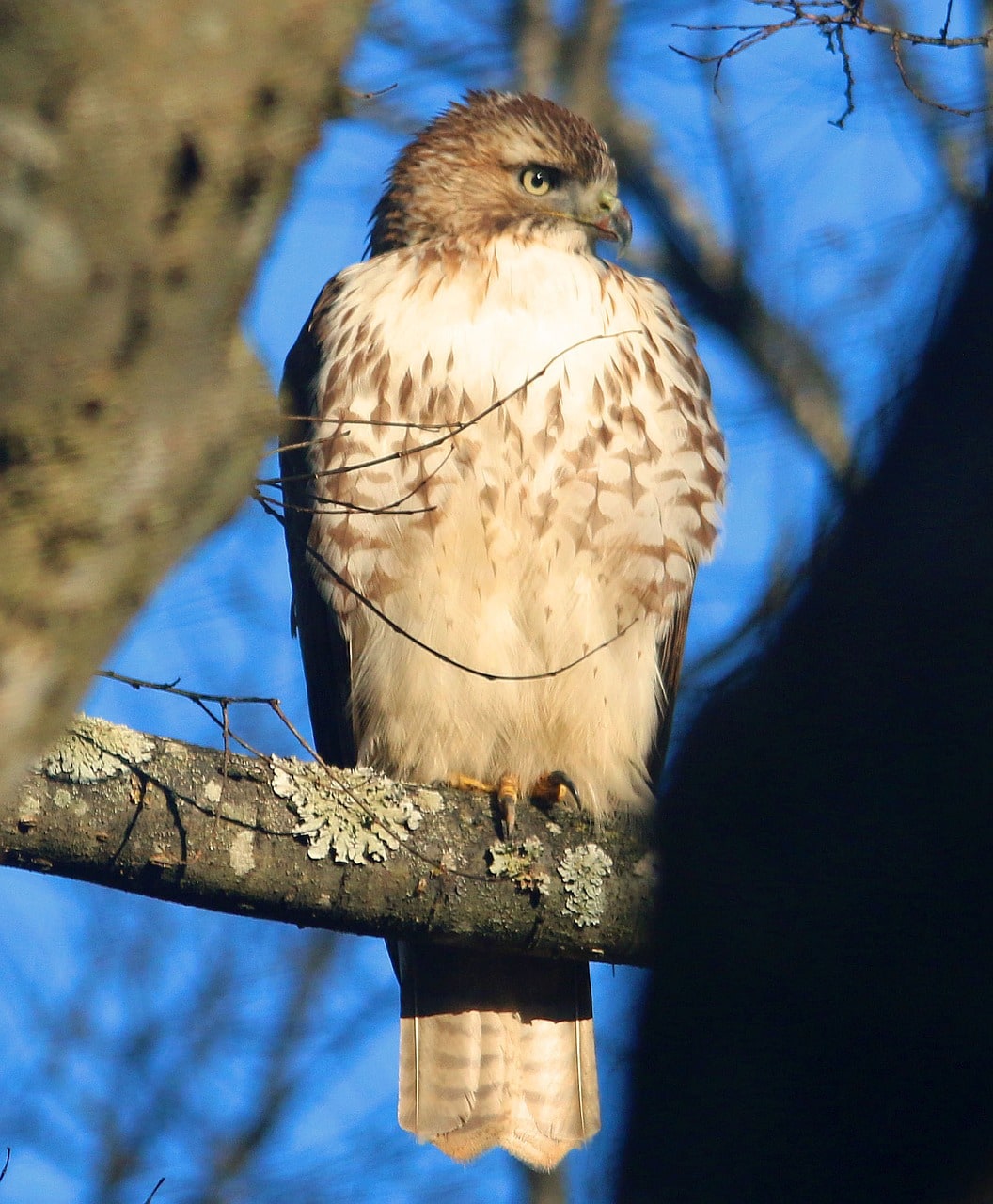
The Sharp-Shinned Hawk is an example of a small hawk species, reaching only 10–14” in length. It is similar in appearance to the Northern Goshawk without the markings around its eyes. It has a slate-colored back, with a long-striped tail and a mottled chest. Its legs are also lengthy for its body size. This body shape allows this bird to maneuver in deep forests with ease.
The Sharp-Shinned Hawk lives all across the United States during the non-breeding season. It hunts primarily small birds, sometimes taking its prey near feeders. The hawk hunts by swooping down and snatching unwary animals. It is also a species of least concern, with its numbers increasing approximately 226%, according to the IUCN. It is one example of the success of the DDT ban in 1972.
3. Cooper’s Hawk (Accipiter cooperii)

The Cooper’s Hawk is the second largest of these three birds at 14–20”. It has a hefty body weight than the Sharp-Shinned Hawk, but otherwise, it is nearly identical. It has a white patch at its neck and a rusty-colored barring pattern on its chest and is one of a few hawks with a striped tail. It occurs all across the United States, sticking to its preferred wooded habitat. However, it will live in suburban or urban areas, too.
The Cooper’s Hawk is a stealthy hunter that surveys its surroundings before gliding down to take its prey. Its prey is small to medium-sized birds. If you have a bird feeder, you’ll likely attract one to your yard. Like the Sharp-Shinned Hawk, it is a species of least concern, with its numbers increasing dramatically in the last 40 years.
Harriers
4. Marsh Hawk (Circus hudsonius)
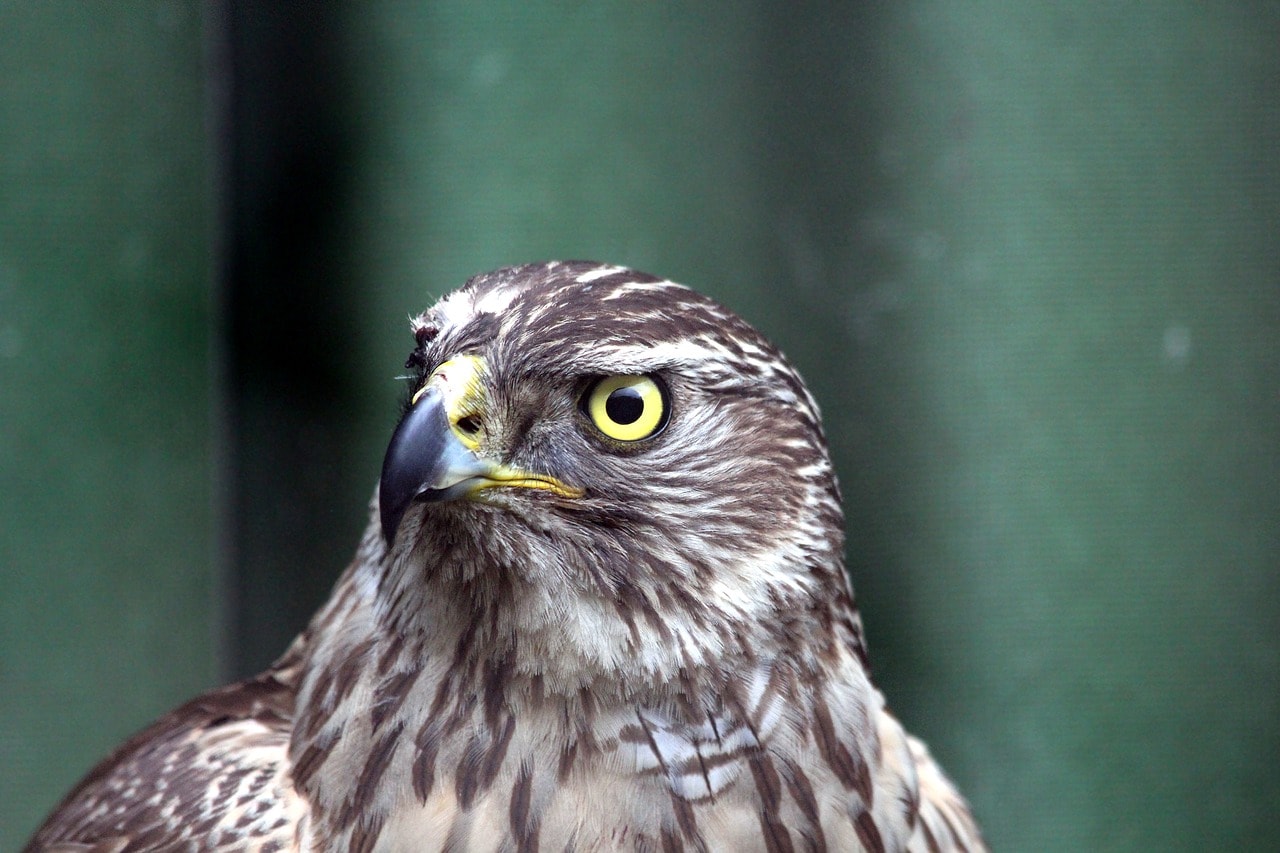
The Marsh Hawk or Northern Harrier is a large, robust bird measuring 17.5–24”. It has a broad wingspan of 40.2–46.5”. Unlike the previous species, it lives in a variety of habitats, from forests to wetlands to grasslands. It glides across the landscape relatively low. It’s one of the ways to identify this hawk in the field. Male birds are gray and females brown. Both have white chests with brown vertical stripes.
Another characteristic feature is its rounded face that resembles an owl. The Marsh Hawk feeds primarily on small to medium mammals and birds. It uses both sight and hearing to locate its prey. Interestingly, there are reports that this hawk sometimes drowns animals. Its numbers have decreased marginally in recent years. However, it still remains a species of least concern.
Buteos
5. Red-Tailed Hawk (Buteo jamaicensis)
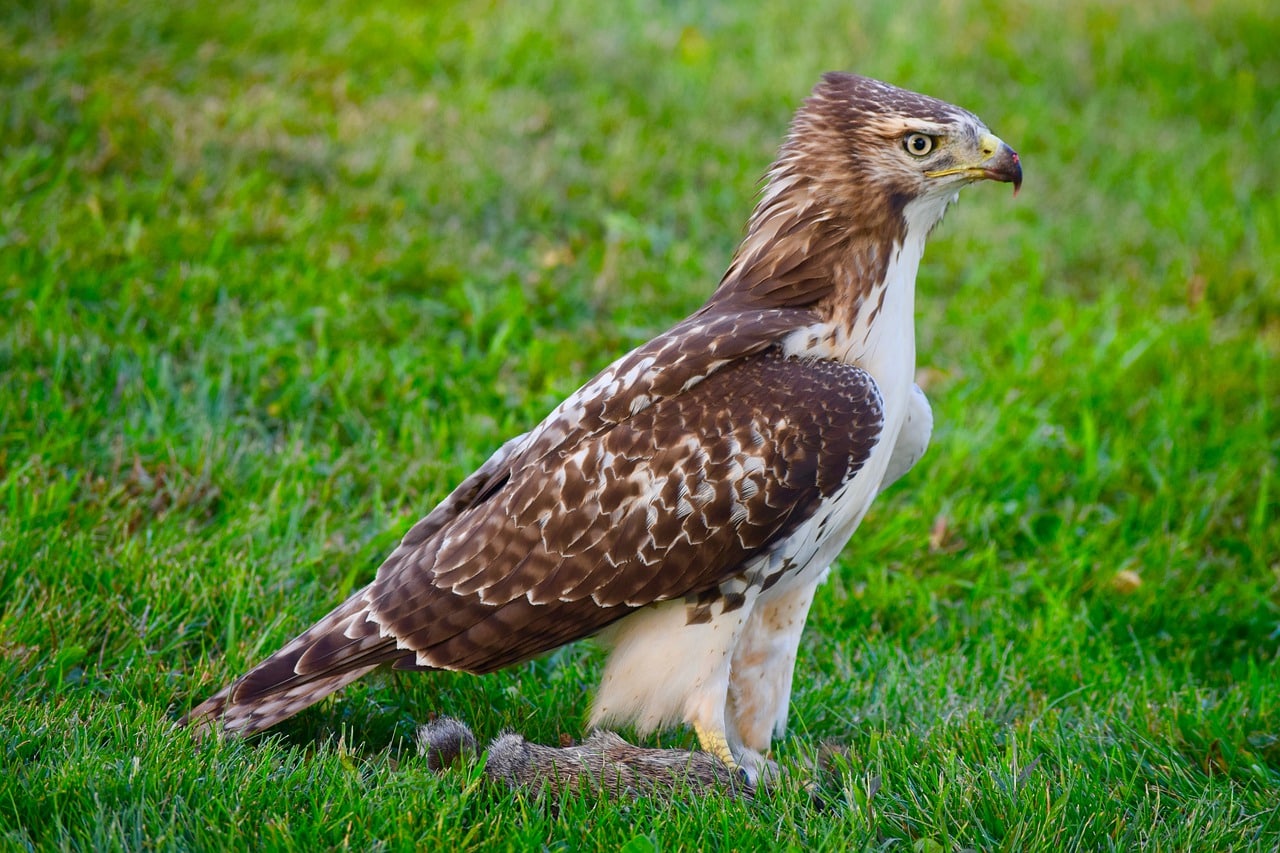
There’s no mistaking the Red-Tailed Hawk, with its broad, rust-colored tail and white chest. It measures 19–25”, with a 44.9–52.4” wingspan. It is the second largest of the Buteos in the United States. Like the Marsh Hawk, its flight pattern in the open country is distinctive, with it flying high overhead on the thermals. It lives all across the United States.
There are different color variations of the Red-Tailed Hawk, including the Harlan’s dark coloration and the Krider’s pale-colored pattern. It feeds on small animals, which it will grab and fly off with their prey in their talons. It has even taken pets on occasion. The species is of least concern, with numbers increasing significantly in the last 40 years, again coinciding with the ban on DDT.
6. White-Tailed Hawk (Geranoaetus albicaudatus)

The White-Tailed Hawk is appropriately named. It is a gray bird with rust-colored shoulders and a white underside. The color extends from its white chest to its broad tail with a black stripe on the bottom. This hawk inhabits southern Texas, where it lives in the open country, savannas, and grasslands. It is 18.1–20.5” long, with a massive 50.4–51.6” wingspan.
The White-Tailed Hawk feeds primarily on small mammals, reptiles, and birds. It acts quickly once it has spotted its prey. While it is a species of least concern, there’s uncertainty regarding its numbers. However, threats exist in its native habitat from development and agriculture that may prompt further investigation from the IUCN.
7. Red-Shouldered Hawk (Buteo lineatus)
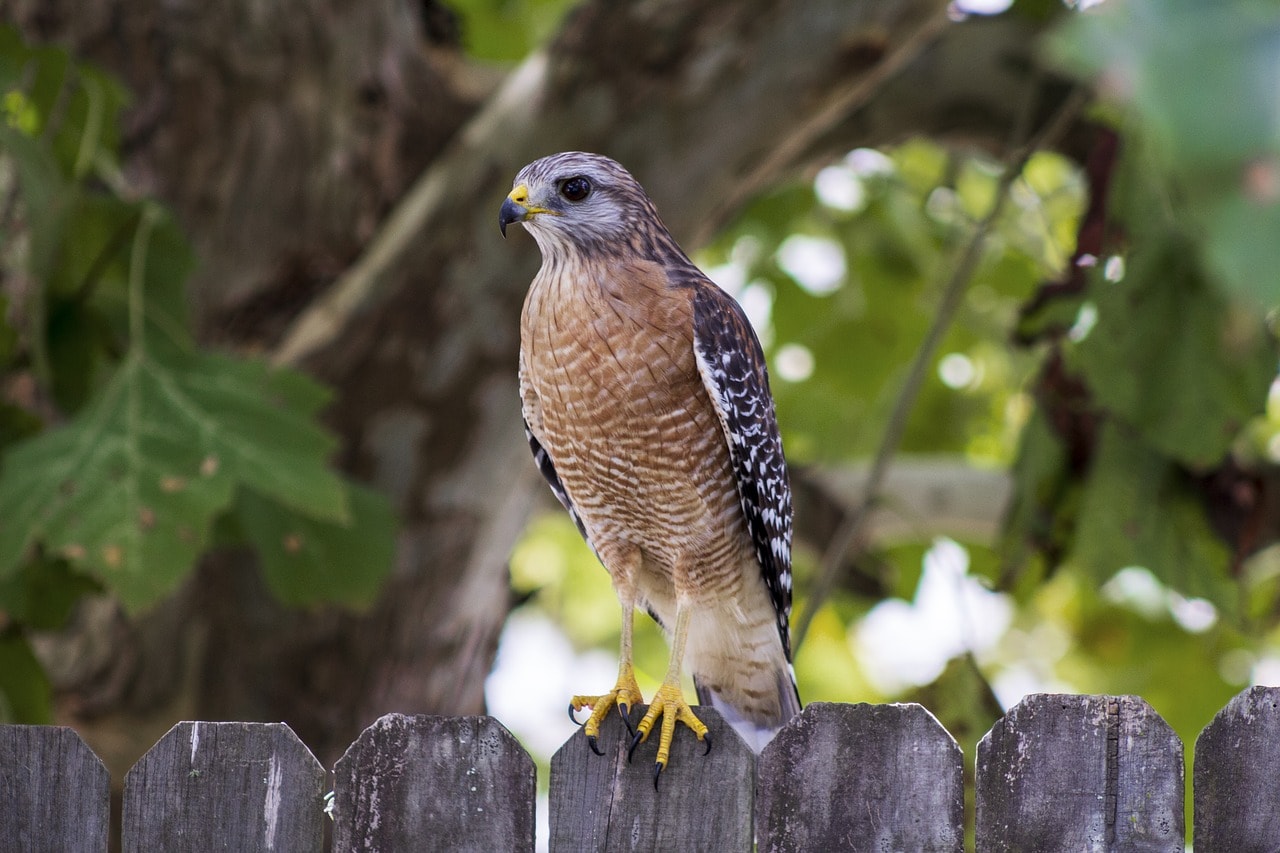
The Red-Shouldered Hawk lives primarily east of the Mississippi River and along the Pacific Northwest coast. Its large size is characteristic of this group, measuring 16.9–24.0” long, with a 37.0–43.7” wingspan. While it has red on its shoulders, it could describe the entire plumage of this bird, with its barred chest and wings. It has a broad, black-striped tail.
The Red-Shouldered Hawk lives in woods that often have a water source nearby. Its main prey is small mammals, with the occasional snake or lizard. Like many birds of prey, this hawk returns to the same nesting area each year. It is a species of least concern, with its numbers increasing 182% over the last 40 years.
8. Gray Hawk (Buteo plagiatus)

The Gray Hawk is another resident of southern Texas and the extreme Southwest. It prefers the open savannas and forests of these areas. It often lives near water and cottonwood trees, where it can catch small animals and lizards. The bird is entirely gray, with some lighter horizontal stripes on its chest and belly. It has a narrow, banded tail. It is 18–24” long.
Like many in this group, the Gray Hawk often soars, catching a lift from the thermals. Its behavior and hunting resemble that of Accipiters more than Buteos. It is a species of least concern, with stable population numbers in recent years. However, it has a large range that extends into Central and South America.
9. Rough-Legged Hawk (Buteo lagopus)
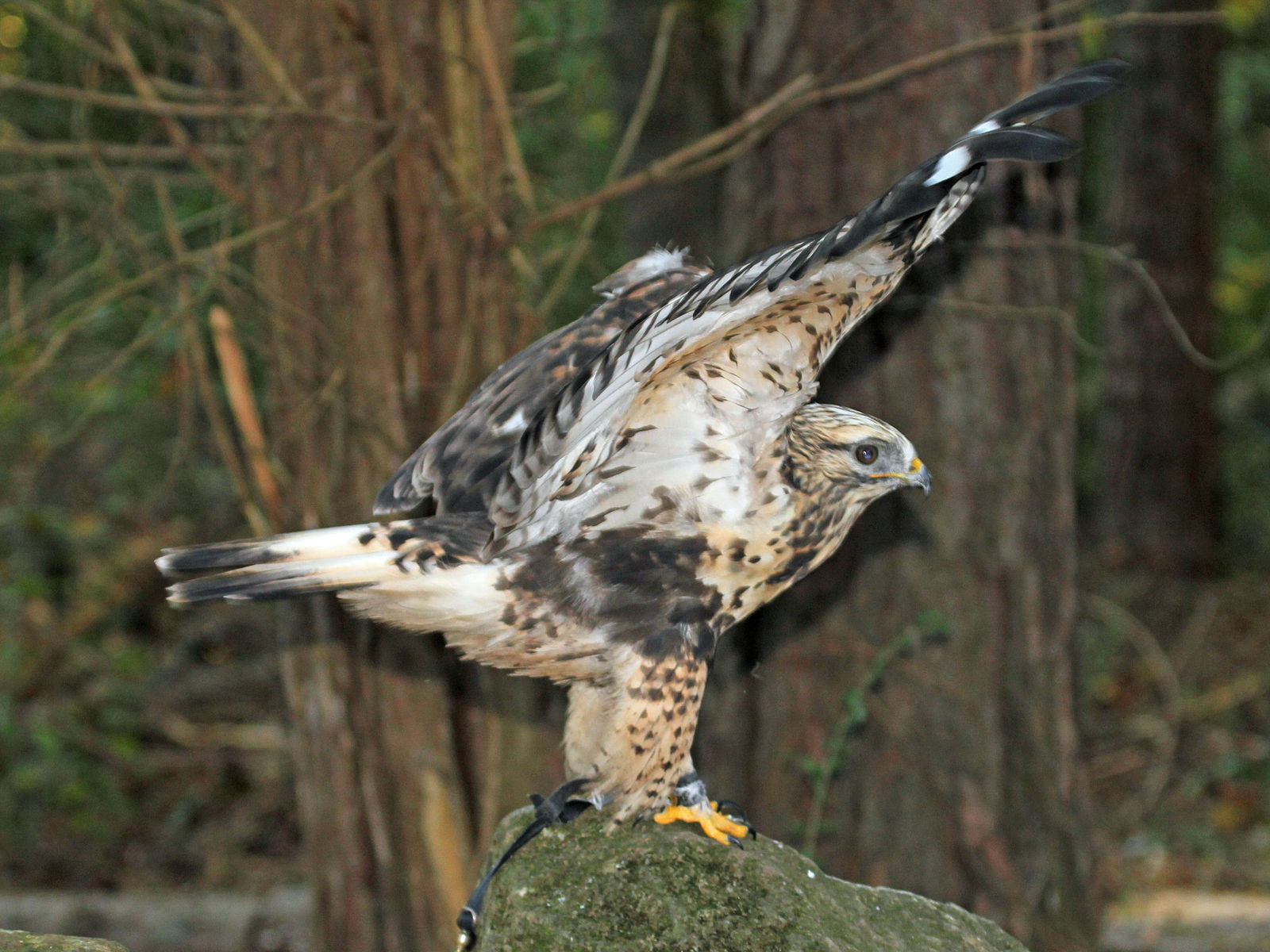
The Rough-Legged Hawk differs from others in this genus in that it will hover and flap its wings rapidly instead of soaring as others do. It is a brown bird with a mottled chest and a white tail with a broad, black band. It is a large species, measuring 19–24” long, with a 52.0–54.3” wingspan. It gets its name from the feathering on its legs.
The Rough-Legged Hawk prefers open habitat, with rocky hills and outcroppings where it will nest. Its breeding range is the tundra, but its non-breeding range is throughout the lower 48. The IUCN classifies this hawk as a species of least concern. Its North American population is stable, with few threats to its conservation status.
10. Zone-Tailed Hawk (Buteo albonotatus)
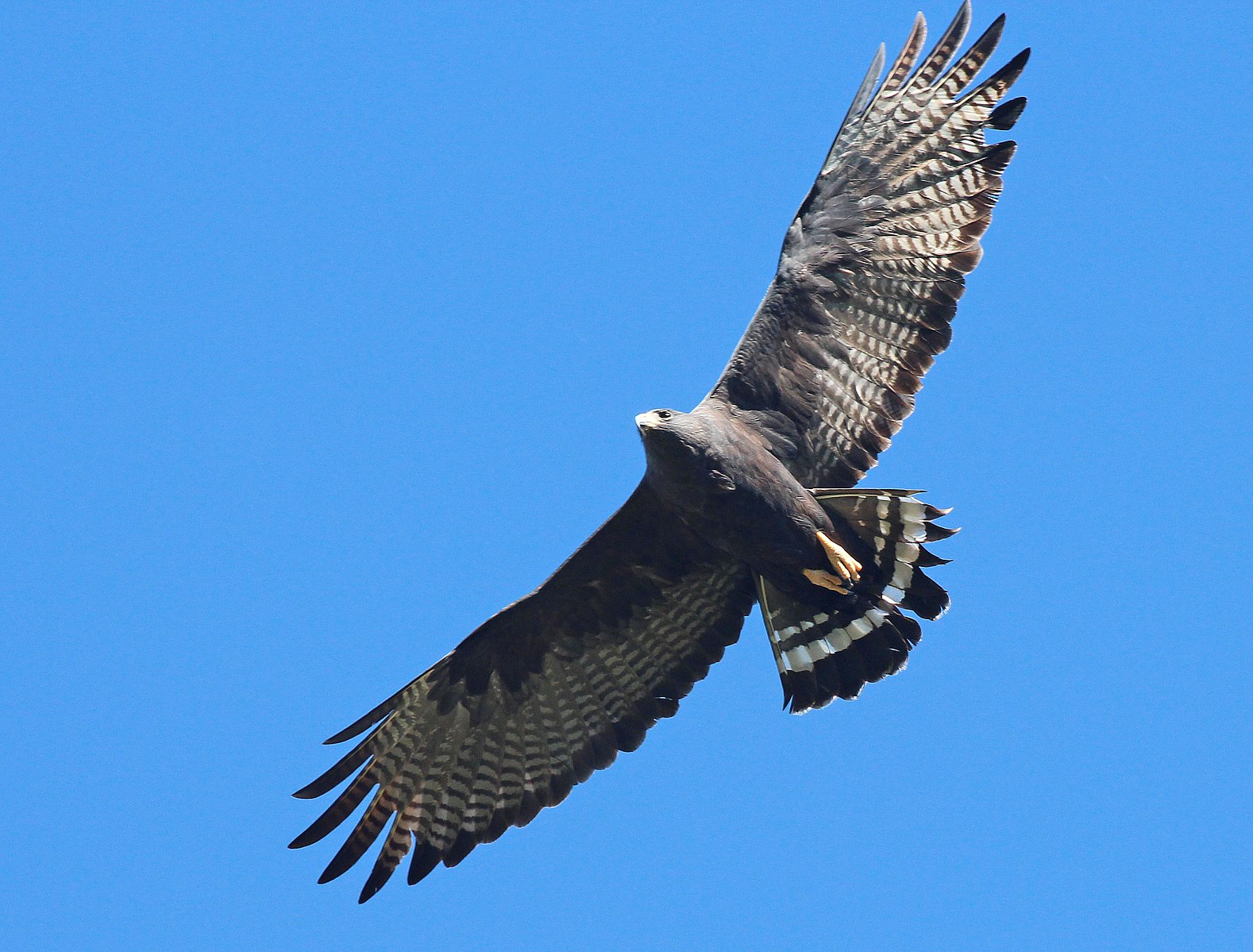
The Zone-Tailed Hawk is a handsome bird that is all gray except for the white bars on its tail. There are some mottling and bars on the wings, with darker tips. At first glance, it’s easy to mistake it for a Turkey Vulture, save its black head. It’s a smaller species, measuring 17.7–22.1” long. It’s an opportunistic feeder that will take reptiles, birds, or mammals. It hunts by pouncing on its prey.
The Zone-Tailed Hawk lives in the warmer climes of the American Southwest, where it inhabits the wooded canyons and shrublands of this area. It soars, with a wing position that also resembles the Turkey Vulture. Its population is stable, making it a species of least concern. However, its range has increased in recent years.
11. Swainson’s Hawk (Buteo swainsoni)
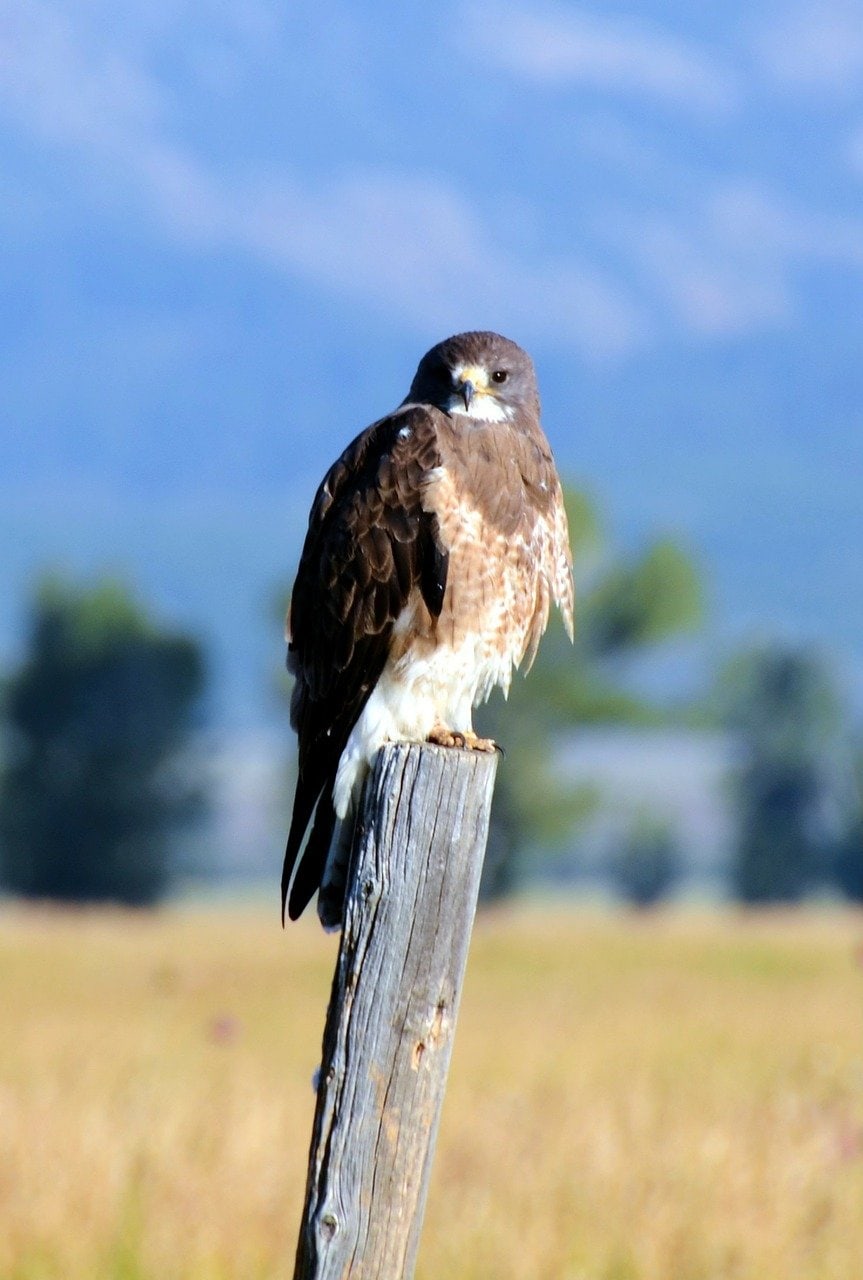
The Swainson’s Hawk is a creature of the plains west of the Mississippi. Its range extends through Canada and into Alaska. It lives in the open country of savannas, grasslands, and shrublands that define these areas. The bird has a falcon-like appearance, with narrower wings and tail that are typical of this genus. It is a medium-sized hawk at 19–22” long.
The Swainson’s Hawk has a white chest and a brown mottled belly. Like others of its kind, you’ll often see this bird soaring, looking for prey. It feeds on rodents and small mammals, taking the occasional lizard, too. The IUCN lists it as a species of least concern due in part to its stable population that has held its own for over 40 years.
12. Broad-Winged Hawk (Buteo platypterus)

The Broad-Winged Hawk is a stocky bird, measuring 14–19” long. It is primarily brown, with a white mottled chest that provides excellent camouflage in its forest habitat. Its call is unmistakable as a loud whistle, which other birds, such as Blue Jays, often mimic. Its breeding range is the eastern half of the United States, going north across the eastern and western borders of Canada.
The Broad-Winged Hawk is an opportunistic predator that will feed on a variety of small animals, including snakes. It will keep watch until its prey close to its perch and swoop down for the kill. Like many birds of prey, its population has recovered and continues to increase over the last 40 years. It’s a species of least concern because of its recovery.
13. Harris’s Hawk (Parabuteo unicinctus)

The Harris’s Hawk looks like a cross between a hawk and a falcon. It has long legs on its primarily brown-gray body. It has a white rump, with a broad brown swath and white band at the bottom. It’s a larger bird at 18.1–23.2” long and a 40.5–46.9” wingspan. It is an inhabitant of the scrublands of the Southwest, with a range that extends into Central America.
The Harris’s Hawk is unique in that it hunts small mammals cooperatively with other cohorts. This social behavior is unusual for birds that typically are solitary or live in pairs. While that trait can improve its survival, it hasn’t impacted its population, which is decreasing. Nonetheless, the IUCN lists it as a species of least concern.
14. Short-Tailed Hawk
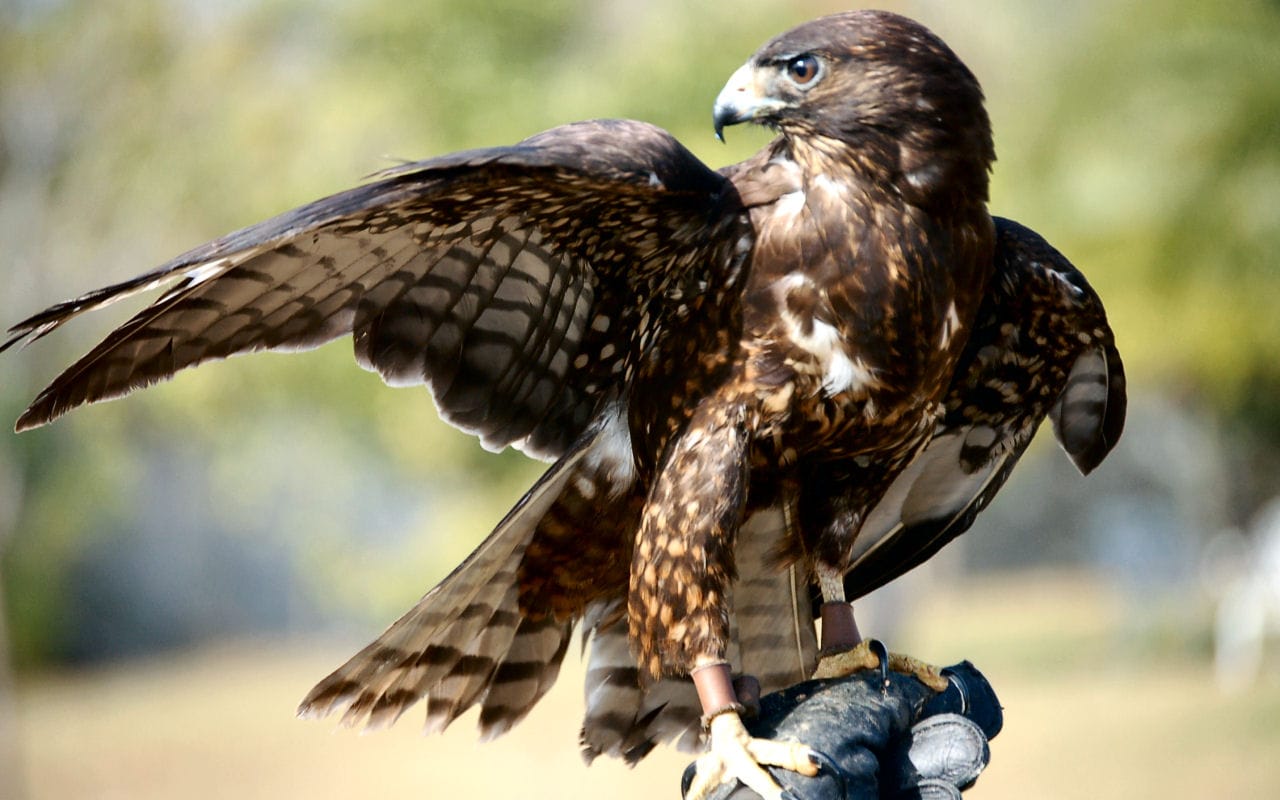
The Short-Tailed Hawk is a smaller size at 17” long. It has a brown back, with a white underside and banded tail. Its head is dark-colored except for a light patch under its chin. It has piercing black eyes that are hard to miss. Like the Rough-Legged Hawk, it has an unusual hunting behavior where it will appear to stop in mid-flight before diving in for the kill.
The Short-Tailed Hawk is at home in the cypress swamps and mangroves of Florida, where it is a year-round resident. It feeds primarily on songbirds, but it will take the occasional tree frog or lizard. This bird isn’t a common sighting anywhere that it inhabits. Nevertheless, it is a species of least concern, with a stable population for the last several decades.
15. Ferruginous Hawk

The Ferruginous Hawk is the largest Buteo found in the United States. It gets up to 27.2” long, with a 52.4–55.9” wingspan. True to its name, it is a brown bird with a solid white chest in the light morph. Another variant has a mottled chest. There is also a less common all-dark morph. The hawk is stocky, with feathered feet.
Its habitat is the plains of the West, where it feeds on small mammals, even Prairie Dogs. Like the Harris’s Hawk, it also hunts cooperatively, especially with the latter prey. It also exhibits the typical bird of prey behavior, soaring on thermals. Despite threats from ranching and agriculture, the Ferruginous Hawk’s numbers are increasing, making it a species of least concern.

Conclusion
Hawks are magnificent creatures, with a variety of strategies for hunting and surviving often harsh conditions of their habitats. There are, indeed, survivors. As you’ve seen, they are some of the largest birds in the country, surpassed only by the Bald Eagle and Golden Eagle. Like these birds of prey, hawks rely on their sharp eyesight and surprise tactics to make a living as a top predator. With so many types of hawks in the United States, it really is worth getting out to see one of these amazing birds.
Featured Image Credit: Pixabay
Table of Contents
- Top 15 Types Of Hawk in the US
- Accipiters
- Harriers
- Buteos
- 5. Red-Tailed Hawk (Buteo jamaicensis)
- 6. White-Tailed Hawk (Geranoaetus albicaudatus)
- 7. Red-Shouldered Hawk (Buteo lineatus)
- 8. Gray Hawk (Buteo plagiatus)
- 9. Rough-Legged Hawk (Buteo lagopus)
- 10. Zone-Tailed Hawk (Buteo albonotatus)
- 11. Swainson’s Hawk (Buteo swainsoni)
- 12. Broad-Winged Hawk (Buteo platypterus)
- 13. Harris’s Hawk (Parabuteo unicinctus)
- 14. Short-Tailed Hawk
- 15. Ferruginous Hawk
- Conclusion
About the Author Robert Sparks
Robert’s obsession with all things optical started early in life, when his optician father would bring home prototypes for Robert to play with. Nowadays, Robert is dedicated to helping others find the right optics for their needs. His hobbies include astronomy, astrophysics, and model building. Originally from Newark, NJ, he resides in Santa Fe, New Mexico, where the nighttime skies are filled with glittering stars.
Related Articles:
How to Clean a Refractor Telescope: Step-by-Step Guide
How to Clean a Telescope Eyepiece: Step-by-Step Guide
How to Clean a Rifle Scope: 8 Expert Tips
Monocular vs Telescope: Differences Explained (With Pictures)
What Is a Monocular Used For? 8 Common Functions
How to Clean a Telescope Mirror: 8 Expert Tips
Brightfield vs Phase Contrast Microscopy: The Differences Explained
SkyCamHD Drone Review: Pros, Cons, FAQ, & Verdict
